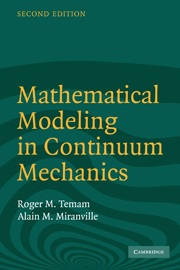Book contents
- Frontmatter
- Contents
- Preface
- A few words about notations
- PART I FUNDAMENTAL CONCEPTS IN CONTINUUM MECHANICS
- PART II PHYSICS OF FLUIDS
- PART III SOLID MECHANICS
- PART IV INTRODUCTION TO WAVE PHENOMENA
- 18 Linear wave equations in mechanics
- 19 The soliton equation: the Korteweg–de Vries equation
- 20 The nonlinear Schrödinger equation
- Appendix: The partial differential equations of mechanics
- Hints for the exercises
- References
- Index
19 - The soliton equation: the Korteweg–de Vries equation
Published online by Cambridge University Press: 06 July 2010
- Frontmatter
- Contents
- Preface
- A few words about notations
- PART I FUNDAMENTAL CONCEPTS IN CONTINUUM MECHANICS
- PART II PHYSICS OF FLUIDS
- PART III SOLID MECHANICS
- PART IV INTRODUCTION TO WAVE PHENOMENA
- 18 Linear wave equations in mechanics
- 19 The soliton equation: the Korteweg–de Vries equation
- 20 The nonlinear Schrödinger equation
- Appendix: The partial differential equations of mechanics
- Hints for the exercises
- References
- Index
Summary
Solitons are a type of nonlinear wave whose discovery and study are relatively recent. Solitons appear in numerous wave propagation phenomena, and they should eventually play a major role in telecommunications by optical fibers. Two well-known equations possess soliton solutions: the Korteweg–de Vries equation and the nonlinear Schrödinger equation; we will present these equations in Chapters 19 and 20, respectively. These equations may be obtained by passing to the limit in various equations (e.g., fluid mechanics, electromagnetism). Let us mention here two remarkable properties of solitons. On the one hand, these are waves that propagate by keeping a constant shape; on the other hand, when two solitons that propagate at different velocities meet, they interact for some time and then recover their initial shapes and continue their propagation with their own initial velocity.
Solitons appear in particular in the small-amplitude motions of the surface of a shallow fluid; they are then governed by the Korteweg–de Vries equation. In this chapter, we write different water-wave equations and show how the Korteweg–de Vries equation may be deduced from the Euler equation of incompressible fluids; we finally present the soliton solutions of the Korteweg–de Vries equation (KdV).
Solitons were discovered by the Englishman John Scott Russell. He noticed the appearance of waves with constant shape propagating over large distances in shallow canals, and he used to follow them on horseback along the banks of the canal (J.S. Russell, 1884). The theoretical (analytical) study of these waves was then undertaken by Korteweg and de Vries, who introduced the equation bearing their names (Korteweg and de Vries (1895)).
- Type
- Chapter
- Information
- Mathematical Modeling in Continuum Mechanics , pp. 289 - 302Publisher: Cambridge University PressPrint publication year: 2005

